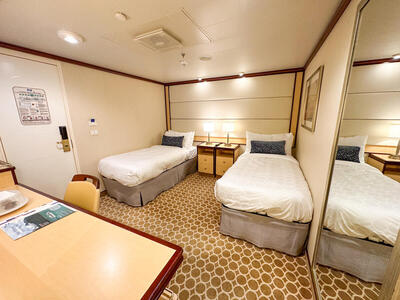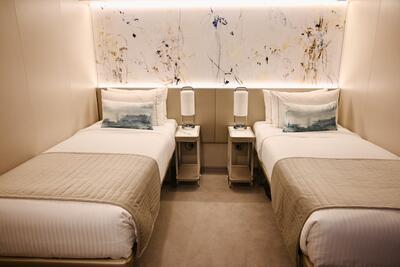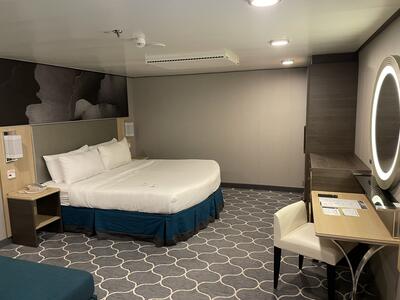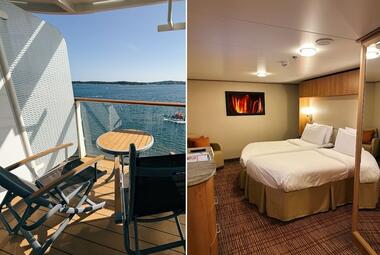Choosing the right cabin for your cruise vacation is as important as selecting the right ship. From tiny interior staterooms to lavish suites, there are a variety of options available. When booking, it's important to establish your budget and evaluate your expectations for your cabin experience.
Let's assume, for example, you're a family of five excited to go on your first-ever cruise. Most cruise ship cabins accommodate a maximum of four passengers, so you'll either have to split your family into two separate staterooms or book a larger cabin.
Perhaps you're daydreaming about sipping a piping hot cup of coffee on your balcony while pulling into port. Though not the most economical stateroom option onboard, a balcony cabin offers guests a private space to unwind while enjoying the stunning sea views.
Confused about where to start? In this guide, I'll explain everything about cruise ship cabins, from stateroom categories to amenities, the best locations onboard, booking tips, and more.
What is a cruise ship cabin?

Cruise ship cabins, also known as staterooms, are similar to hotel rooms because they provide a private space to relax while onboard. In other words, they'll be your "home away from home" while at sea.
Regardless of which category you book, you can expect certain amenities to make your stay comfortable, from basic necessities like an ensuite bathroom, a cozy bed (or beds), storage space, and a desk or vanity area.
However, there are key differences to consider, such as the cabin size and layout. Interior rooms, for example, tend to be much smaller than balcony cabins.

Moreover, some staterooms are designed for families or groups and feature extra beds or separate sleeping areas, while suites are the most luxurious options onboard and offer large living areas, premium amenities, and sometimes access to exclusive areas of the ship.
Understanding these aspects will help you choose a stateroom that enhances your cruising experience and meets your travel party's needs.
The different categories of cruise ship cabins

Onboard every mainstream cruise ship, you'll have four different categories to choose from: interior, ocean view, balcony, and suite. Each category caters to specific preferences and budgets, from economical inside rooms to high-end suites.
Guests in standard staterooms—interior, ocean view, and balcony—will have access to the same amenities onboard, including dining options, entertainment, and more. Passengers staying in suites, however, will enjoy additional perks, such as exclusive dining rooms and sun decks (depending on the ship).
Interior

Inside staterooms are the most affordable cruise ship cabins. As such, they're a great choice for budget-conscious travelers! However, before booking the cheapest cabin, it's important to be aware of a few considerations.
First, they lack windows and natural light, which can make the space feel smaller. If you value daylight and ocean views, this could be a drawback. You won't be able to wake up and peer outside to watch the sunrise or see your ship pull into port. Additionally, they're typically the smallest cabins onboard, with some measuring just 149 square feet. Because of their size, they may not feature small seating areas, which are standard in ocean view and balcony rooms.
Despite these cons, inside staterooms provide a practical and cost-effective option for cruisers who plan on spending most of their time enjoying the ship's amenities, rather than relaxing in their cabin. I've found that when I stay in interior rooms, I'm less likely to sleep in or return to my cabin for an afternoon nap. After all, the point of a cruise is to take advantage of the ship and ports of call!

Royal Caribbean and Disney are the only two cruise lines with interior rooms featuring virtual screens, offering guests real-time views that mimic having a personal balcony or window.
On select Royal Caribbean ships—such as Quantum of the Seas, Anthem of the Seas, Symphony of the Seas, Navigator of the Seas, and Explorer of the Seas—passengers can book an inside cabin with a virtual balcony, an 80-inch LED screen that provides live views from outside the ship into your stateroom.
Similarly, newer Disney cruise ships have interior rooms with virtual portholes. Though smaller than Royal Caribbean's floor-to-ceiling virtual balconies, these windows are sprinkled with a touch of Disney magic, with beloved characters making appearances every so often.

Royal Caribbean's Oasis and Icon Class also have cabins with windows that face the interior of the ship, giving guests a view of the iconic Central Park, Boardwalk, or Surfside Neighborhoods. Though they have a window and therefore allow natural light to seep into the stateroom, they don't have an ocean view. As such, they're designated as a subcategory of interior rooms.
Carnival has a few similar rooms called "Interior with Picture Window (Walkway View)" and "Porthole Interior" cabins. The latter rooms feature small circular windows that actually provide an ocean view, while the walkway view cabins lack privacy since they overlook public areas of the ship. However, they have a larger window.
Read more: Inside cabin vs. oceanview on a cruise ship
Ocean view

Ocean view, or outside, cabins feature windows with a view of the ocean, compared to the interior areas of the ship. However, the window cannot be opened, so—like interior staterooms—they lack direct access to fresh air. The windows often have blackout curtains to help passengers adjust the amount of natural light entering the room.
Ocean view rooms with unobstructed views are typically the cheapest cabins within this category, meaning that rather than have a clear view of the ocean, your window will be blocked by a lifeboat or other structure. Though this can affect the quality of your view, you'll still benefit from sunlight.
In addition to natural light, ocean view staterooms are usually larger than inside cabins. For example, a standard interior room on Carnival Celebration measures 158 square feet, while an ocean view room offers a bit more space, around 243 square feet.
Read more: Balcony vs. oceanview cabin on a cruise ship

On newer ships, ocean view staterooms are usually located on the lower decks, or at the forward (front) and (aft) sections of the ship. Between the two, forward cabins usually feel more motion, which isn't ideal for guests worried about seasickness.
Read more: Inside cabin vs. oceanview on a cruise ship
Balcony

Balcony cabins have become increasingly popular throughout the last decade, with many cruise lines building more balconies on new ships than before. These staterooms allow you to step outside onto a private verandah and enjoy the fresh air and stunning views.
On cruises to Alaska or Norway, balcony cabins can really enhance your experience, giving you a front-row seat to view the dramatic fjords. One of my favorite ways to make use of a balcony is to order room service and have a leisurely breakfast al fresco!
Today, balcony cabins come in all shapes and sizes, from traditional ocean-view balconies to those overlooking the ship's interior. Newer Carnival ships also feature Cove Balconies, which are located on the lower decks and offer a unique, closer-to-the-water experience.
Read more: Guide to staying in a Carnival cruise balcony cabin

Like ocean view rooms, the cheapest balcony will typically be obstructed. This means that rather than having a picture-perfect view of the ocean, your cabin may be partially blocked by a lifeboat or support beam. On select ships, interior-facing balconies are often cheaper than ocean-view ones, too.
Royal Caribbean's Oasis Class was the first to introduce interior-facing balconies. These staterooms still have private verandahs; however, they overlook the Central Park and Boardwalk Neighborhoods and provide views of either the lush greenery in the park or the high-energy boardwalk area. On Icon of the Seas, the Boardwalk Neighborhood was replaced with Surfside, a new family-focused area with its own unique amenities.
The size of the balcony varies based on which ship you're sailing on. On Carnival Conquest, for example, the balcony measures 35 square feet, whereas ocean-view balconies on Royal Caribbean's Harmony of the Seas measure 50 square feet.

All balcony cabins come with outdoor furniture, typically two chairs and a small table made from weather-resistant materials.
Suite

If you've got money to burn, or simply want to make your next cruise even more memorable, you'll want to book a suite. The cruise ship suite experience drastically varies based on which cruise line you're sailing with, as well as what ship you're on. For instance, the suite experience on Royal Caribbean's Freedom of the Seas differs from that onboard Wonder of the Seas, despite both vessels sailing for the same line.
From extravagant two- and three-level suites to more understated Junior Suites, there's a lot of variety in what you can expect, making it important to thoroughly research your ship's suite options before booking. The most opulent rooms feature multiple bedrooms, large balconies with hot tubs, exclusive access to suite-only areas, private butlers, and more.
Last year, I cruised in my first cruise suite onboard Carnival Vista. Though I appreciated the larger cabin and upgraded amenities, I was disappointed by the overall perks. Priority boarding was great, but overall, the experience was somewhat standard compared to the high expectations set by other lines, namely Norwegian and Celebrity.
Read more: 8 signs you're ready to move up from a cruise ship balcony to a suite
Solo

Cruising isn't synonymous with multi-generational family vacations. As someone who has taken their fair share of solo cruises, I can attest it's a great way to safely explore the world on your own! However, one of the most annoying aspects of cruising alone is the single supplement fee. This additional charge, which can be up to 100% of the cost of a second guest, usually makes solo cruising more expensive than sailing with someone else.
One way to avoid the single supplement fee is to book a solo cruise cabin. Though not available on every ship, these rooms are designed for one guest, meaning you'll pay the price of just one cruiser, rather than two. While they're typically smaller than standard cabins, they're efficiently designed to maximize space and comfort with the same amenities found in traditional staterooms, including an ensuite bathroom, television, cozy bed, and storage space.
Additionally, some cruise lines have special solo events to help guests traveling alone connect with other passengers.
Read more: Take a look at a solo cabin on Norwegian Encore
All cruise ships have accessible cabins

Those with mobility issues may be apprehensive about taking a cruise. Thankfully, there's no need to worry—all cruise ships have accessible cabins! These staterooms are larger than standard cabins and are equipped with features like wider doorways, grab bars, roll-in showers, and lower sinks to accommodate wheelchair-bound passengers.
The number of accessible staterooms varies based on the ship. Carnival Celebration, for example, has 82 accessible cabins, whereas Icon of the Seas has just 50. As such, it's important to book your cruise in advance, so you can ensure that you can secure one of the limited accessible staterooms onboard.
I was randomly assigned an accessible cabin while sailing on Symphony of the Seas and was surprised by its spaciousness! While it was an inside stateroom, Royal Caribbean placed a lot of thought into the amount of space and design. For instance, I never had issues with the roll-in shower flooding!
Cruise ship cabins for large families

Most cruise ship staterooms fit a maximum of four passengers, meaning that families of five and larger typically have to reserve two cabins. This can sometimes be expensive and inconvenient, especially if traveling with younger children.
Thankfully, larger families don't have to book suites to fit in the same cabin. Many lines offer cabins designed to accommodate larger groups, such as Royal Caribbean's "Ultra Spacious" staterooms. Not only are these rooms far more spacious than standard cabins, but they feature more sleeping options, including bunk beds and a sofa bed.
Similarly, select Carnival ships have "Deluxe Ocean View" cabins, which have one full bathroom, a separate washroom with a sink and tub, and sleeping arrangements for five guests. These can be found onboard Carnival Dream Class ships, as well as within the Family Harbor area on newer ships like Carnival Vista and Carnival Horizon.
Best location

Ultimately, the best location for your cruise ship cabin is based on your personal preferences, such as your sensitivity to motion, desire for privacy, and interest in certain onboard amenities.
For example, if you're worried about motion sickness, you'll want to choose a midship stateroom with a view, avoiding the front of the ship. However, if you prioritize wake views and larger balconies, you might select an aft balcony cabin.
And if you want to be close to the center of the action and don't mind a little noise bleed from the public areas, a stateroom near the lido deck or other popular venues might suit you better.
Read more: Best rooms on a cruise ship: Deck, location, & category
Guaranteed cabins

An easy way to save money on your fare is by selecting a guaranteed stateroom. Rather than selecting your cabin at the time of booking, the cruise line will assign it to you closer to your departure date. Though you won't know your exact room assignment until later, you will enjoy the same onboard amenities.
There are pros and cons to booking a guaranteed cabin, with the most obvious advantage being that you'll save money. Sometimes, you may be pleasantly surprised with an upgrade, though these instances are rare.
However, a major downside is that you won't have control over your stateroom's location, meaning that you could be placed near a noisy elevator shaft, another undesirable area, or with an obstructed view. Additionally, if you have specific preferences, such as adjoining cabins, a guaranteed cabin might not meet those needs.
Cheapest cruise ship cabins

The cheapest cruise cabins are typically guaranteed inside cabins. These no-frill staterooms lack windows or natural light, which helps keep their cost lower compared to more desirable cabins with views. They're also often the smallest staterooms onboard. Many, for example, don't have separate seating areas.
Inside cabins are ideal for budget travelers who want to stretch their money as far as possible. Rather than spending extra money on a room with a private balcony, passengers staying in interior staterooms usually prioritize enjoying the ship's amenities, spending as little time in their cabin as possible.
Moreover, the less money spent on accommodations, the more money that can be spent on add-ons, further enhancing the cruise experience, from drink packages to spa treatments, shore excursions, Wi-Fi, and more.

Let's take a look at the price for an 8-night cruise onboard Carnival Horizon in July 2025. An interior room begins at $979 per person, whereas a balcony cabin starts at $1,479 per person. In total, booking a balcony stateroom would cost around $500 more per guest, which can quickly add up, whether you're traveling with just one other person or a family of four.
Upgrade cabin

Just like with hotel rooms and flights, there's nothing quite better than checking in and being notified that you were upgraded. Frequent fliers with status and loyal hotel guests usually have a better chance of receiving complimentary upgrades as part of their benefits.
Cruise ships, however, operate a little differently, as upgrades are based on availability. You can score a cruise cabin upgrade in a few ways. Some cruise lines, such as Royal Caribbean, Norweigan, and Celebrity, allow you to bid for a cruise ship cabin upgrade.
Other lines send out upgrade offers via email. For example, last year, my travel agent forwarded me an email about an upgrade opportunity for my cruise on Carnival Celebration. Though I ultimately decided against it, the process was easy, as the email included a link where I could view the offer and confirm the upgrade.
Read more: 12 easy ways how to get a cabin upgrade on a cruise








